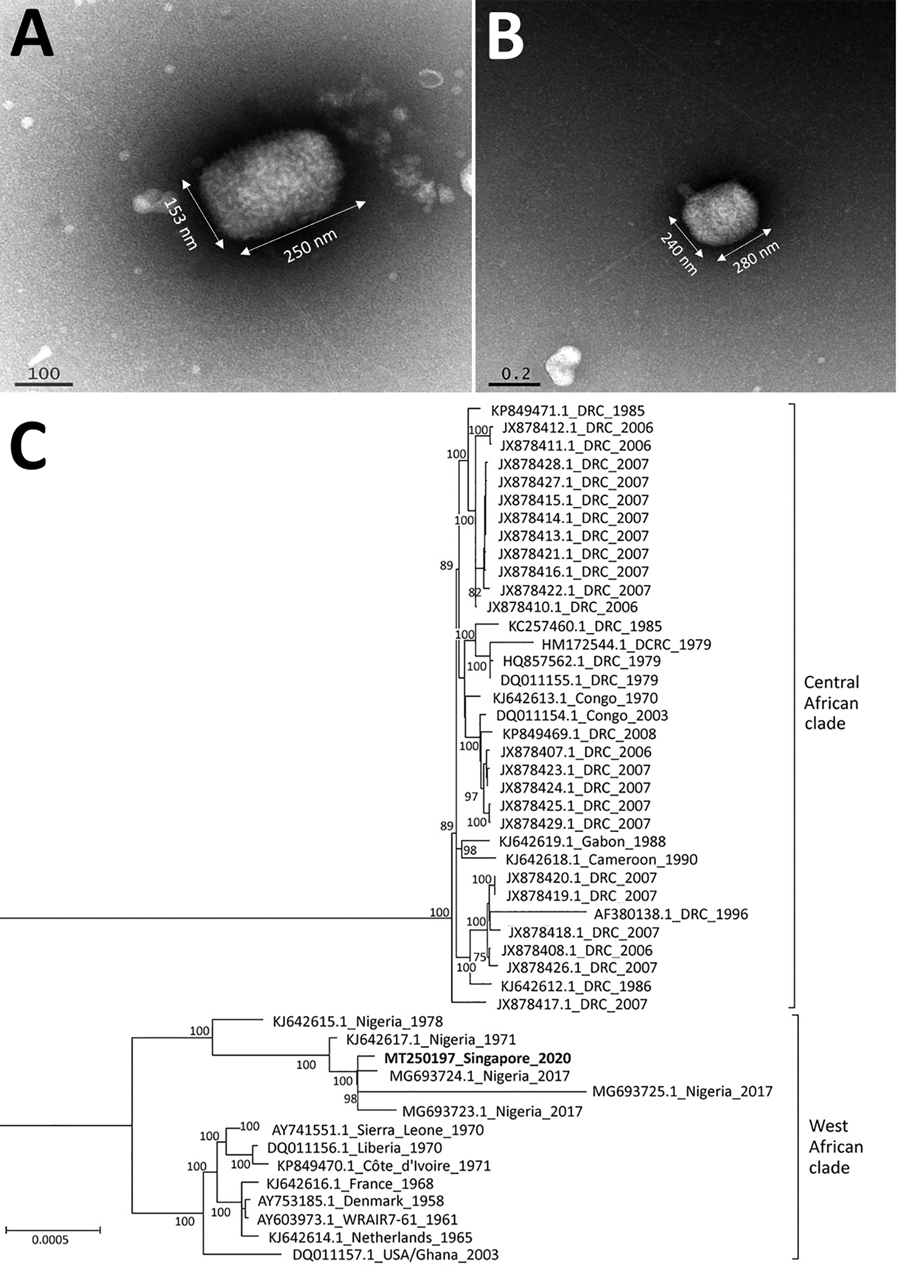Volume 26, Number 8—August 2020
Dispatch
Imported Monkeypox, Singapore
Figure 2

Figure 2. Transmission electron microscopy and maximum-likelihood phylogenetic tree of monkeypox virus in 38-year-old man, Singapore, 2019. A, B) Multiple brick-shaped particles, ranging from 230–290 nm by 130–240 nm, were observed from vesicle fluid under transmission electron microscopy. Tubular structures were observed with phosphotungstic acid stain (A), and a central ring-like depression was observed with gadolinium acetate stain (B). C) Phylogeny of monkeypox sequences, with the patient’s monkeypox strain in bold. All strains are identified by GenBank accession number, location, and year. The evolutionary relationships between monkeypox strains was determined based on 184,338 bases within the central core region of the monkeypox genome. The maximum-likelihood tree was created using RAxML (10) with γ-distributed rate differences and 1,000 bootstrap validation. Only bootstrap values >70% are displayed on the internal branches. Central African and West African clades are indicated. Scale bar indicates genetic distance between sequences.
References
- Yinka-Ogunleye A, Aruna O, Dalhat M, Ogoina D, McCollum A, Disu Y, et al.; CDC Monkeypox Outbreak Team. Outbreak of human monkeypox in Nigeria in 2017-18: a clinical and epidemiological report. Lancet Infect Dis. 2019;19:872–9.PubMedGoogle Scholar
- Centers for Disease Control and Prevention. Monkeypox in Nigeria. 2019 [cited 2019 Sep 15]. https://wwwnc.cdc.gov/travel/notices/watch/monkeypox-nigeria
- Vaughan A, Aarons E, Astbury J, Balasegaram S, Beadsworth M, Beck CR, et al. Two cases of monkeypox imported to the United Kingdom, September 2018. Euro Surveill. 2018;23:23.PubMedGoogle Scholar
- Erez N, Achdout H, Milrot E, Schwartz Y, Wiener-Well Y, Paran N, et al. Diagnosis of imported monkeypox, Israel, 2018. Emerg Infect Dis. 2019;25:980–3.PubMedGoogle Scholar
- Centers for Disease Control and Prevention. 2003 United States outbreak of monkeypox. 2018 [cited 2019 Aug 17]. https://www.cdc.gov/poxvirus/monkeypox/outbreak.html
- Kulesh DA, Baker RO, Loveless BM, Norwood D, Zwiers SH, Mucker E, et al. Smallpox and pan-orthopox virus detection by real-time 3′-minor groove binder TaqMan assays on the roche LightCycler and the Cepheid smart Cycler platforms. J Clin Microbiol. 2004;42:601–9.PubMedGoogle Scholar
- Gelderblom HR, Madeley D. Rapid viral diagnosis of orthopoxviruses by electron microscopy: optional or a must? Viruses. 2018;10:
E142 .PubMedGoogle Scholar - Li Y, Olson VA, Laue T, Laker MT, Damon IK. Detection of monkeypox virus with real-time PCR assays. J Clin Virol. 2006;36:194–203.PubMedGoogle Scholar
- Katoh K, Standley DM. MAFFT: iterative refinement and additional methods. Methods Mol Biol. 2014;1079:131–46.PubMedGoogle Scholar
- Stamatakis A. RAxML version 8: a tool for phylogenetic analysis and post-analysis of large phylogenies. Bioinformatics. 2014;30:1312–3.PubMedGoogle Scholar
- Centers for Disease Control and Prevention. Monkeypox—transmission. 2015 [cited 2019 Sep 3]. https://www.cdc.gov/poxvirus/monkeypox/transmission.html
- Vaughan A, Aarons E, Astbury J, Brooks T, Chand M, Flegg P, et al. Human-to-human transmission of monkeypox virus, United Kingdom, October 2018. Emerg Infect Dis. 2020;26:782–5.PubMedGoogle Scholar
- Brown K, Leggat PA. Human monkeypox: current state of knowledge and implications for the future. Trop Med Infect Dis. 2016;1:8.PubMedGoogle Scholar
- Ho ZJM, Hapuarachchi HC, Barkham T, Chow A, Ng LC, Lee JMV, et al.; Singapore Zika Study Group. Outbreak of Zika virus infection in Singapore: an epidemiological, entomological, virological, and clinical analysis. Lancet Infect Dis. 2017;17:813–21.PubMedGoogle Scholar
- Alirol E, Getaz L, Stoll B, Chappuis F, Loutan L. Urbanisation and infectious diseases in a globalised world. Lancet Infect Dis. 2011;11:131–41.PubMedGoogle Scholar